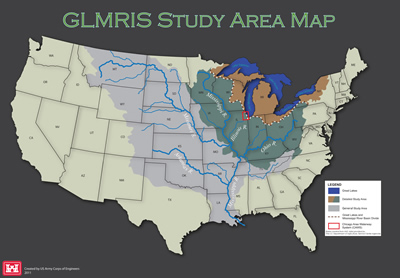Significantly, the GLMRIS report neither makes recommendations nor prioritizes the various options. The report simply presents each of the eight alternative plans, including its general location, a description of its conceptual design elements, an estimated implementation time, and estimated project cost.
The eight alternatives evaluated include:
- No Further Action: Taking no new federal action, at no additional capital costs and no duration to implement.
- Nonstructural Management Approaches: Using nonstructural control technologies (i.e., removal of invasive species, chemical control, educational programs) (Estimated cost $68 million; implementable immediately).
- Constructing New Chicago Waterway Gate System: Maintaining the current operation on the Chicago Area Waterway System (CAWS) while constructing a new gate system (to be called the "GLMRIS Lock") to allow boat traffic to pass between the water basins. Alternative involves the GLMRIS Lock, lock channel, electric barriers and invasive species treatment plants at two mid-system locations in the CAWS. (Estimated cost: $15.5 billion; construction duration: 25 years).
- Maintaining Chicago Area Waterway System Plus Buffer: The current CAWS operations would be maintained. In addition, a new invasive species "buffer zone" within the system would be created (i.e., using the same technologies as alternative number 3, preventing downstream passage from Lake Michigan at five points and preventing upstream passage at a single point at Brandon Road Lock and Dam) (Estimated cost $7.8 billion; construction duration: 10 years).
- Hydrological Separation at Four Locations: Hydrologic separation with physical barriers separating the basins at four locations along the lakefront of Lake Michigan. (Estimated cost: $18.3 billion; construction duration: 25 years).
- Hydrological Separation at Two Locations: "Mid-system" hydrologic separation with physical barriers separating the basins at two mid-system locations. (Estimated cost $15.5 billion; construction duration: 25 years).
- Hybrid Open Control-Hydrological Separation #1: A hybrid of technology and physical barriers at four mid-system locations, leaving the Cal-Sag channel open, combining open control technologies with hydrologic separation barriers (Estimated cost $15 billion; construction duration: 25 years).
- Hybrid Open Control-Hydrological Separation #2: A hybrid of technology and physical barriers at four mid-system locations, leaving the Chicago Sanitary and Ship Canal open, combining open control technologies with hydrologic separation (Estimated cost $8.3 billion; construction duration: 25 years).
The Army Corps is soliciting public comment on the alternatives presented in its GLMRIS report. Comments can be submitted online (comment submission form can be found here), sent to the GLMRIS Team via traditional mail or hand-delivery (Chicago District, U.S. Army Corps of Engineers, 231 S. LaSalle Street, Chicago, IL 60604), or presented during one of seven planned Army Corps-hosted public meetings at the following locations and dates:
- Chicago, IL – Thursday, January 9, 2014
- Milwaukee, WI – Monday, January 13, 2014
- Cleveland, OH – Thursday, January 16, 2014
- Ann Arbor, MI – Tuesday, January 21, 2014
- Traverse City, MI – Thursday, January 23, 2014
- Twin Cities, MN – Monday, January 27, 2014
- St. Louis, MO – Thursday, January 30, 2014
Comments will be accepted until 30 days following the last public meeting, or March 3, 2014.

No comments:
Post a Comment